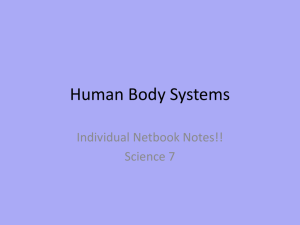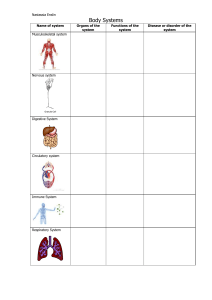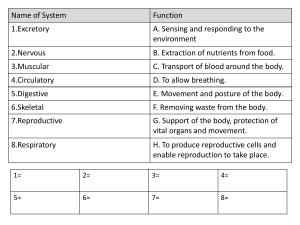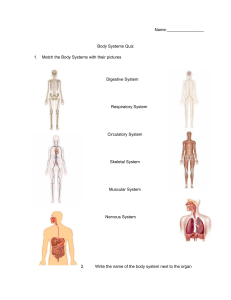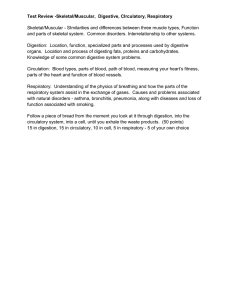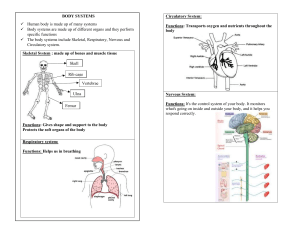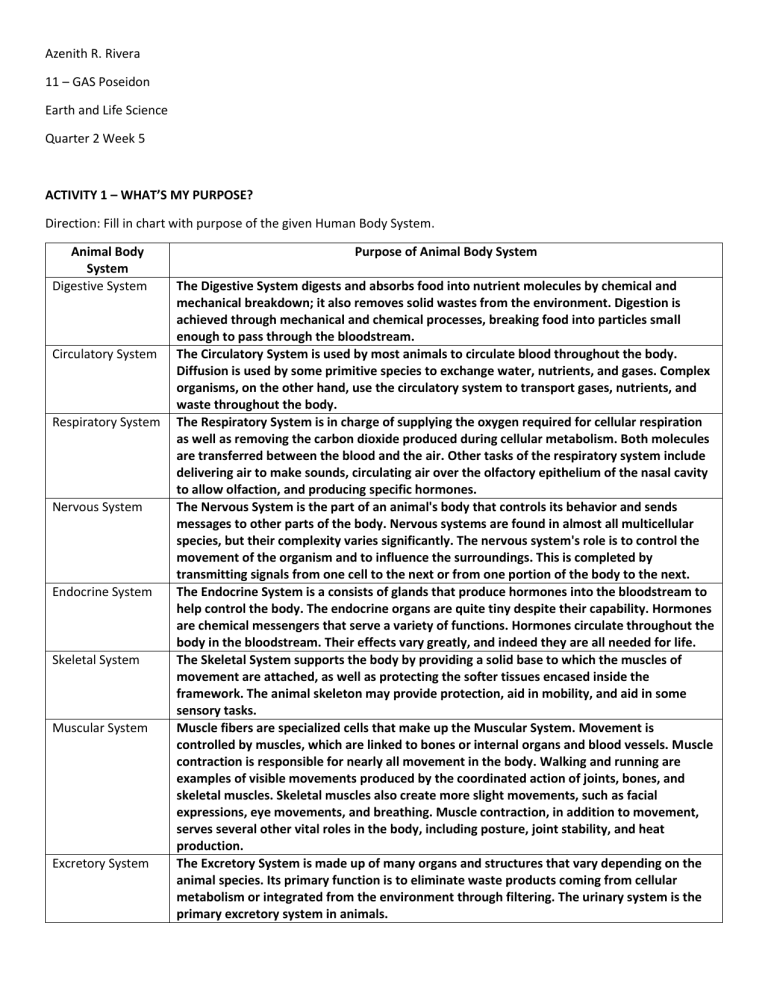
Azenith R. Rivera 11 – GAS Poseidon Earth and Life Science Quarter 2 Week 5 ACTIVITY 1 – WHAT’S MY PURPOSE? Direction: Fill in chart with purpose of the given Human Body System. Animal Body System Digestive System Circulatory System Respiratory System Nervous System Endocrine System Skeletal System Muscular System Excretory System Purpose of Animal Body System The Digestive System digests and absorbs food into nutrient molecules by chemical and mechanical breakdown; it also removes solid wastes from the environment. Digestion is achieved through mechanical and chemical processes, breaking food into particles small enough to pass through the bloodstream. The Circulatory System is used by most animals to circulate blood throughout the body. Diffusion is used by some primitive species to exchange water, nutrients, and gases. Complex organisms, on the other hand, use the circulatory system to transport gases, nutrients, and waste throughout the body. The Respiratory System is in charge of supplying the oxygen required for cellular respiration as well as removing the carbon dioxide produced during cellular metabolism. Both molecules are transferred between the blood and the air. Other tasks of the respiratory system include delivering air to make sounds, circulating air over the olfactory epithelium of the nasal cavity to allow olfaction, and producing specific hormones. The Nervous System is the part of an animal's body that controls its behavior and sends messages to other parts of the body. Nervous systems are found in almost all multicellular species, but their complexity varies significantly. The nervous system's role is to control the movement of the organism and to influence the surroundings. This is completed by transmitting signals from one cell to the next or from one portion of the body to the next. The Endocrine System is a consists of glands that produce hormones into the bloodstream to help control the body. The endocrine organs are quite tiny despite their capability. Hormones are chemical messengers that serve a variety of functions. Hormones circulate throughout the body in the bloodstream. Their effects vary greatly, and indeed they are all needed for life. The Skeletal System supports the body by providing a solid base to which the muscles of movement are attached, as well as protecting the softer tissues encased inside the framework. The animal skeleton may provide protection, aid in mobility, and aid in some sensory tasks. Muscle fibers are specialized cells that make up the Muscular System. Movement is controlled by muscles, which are linked to bones or internal organs and blood vessels. Muscle contraction is responsible for nearly all movement in the body. Walking and running are examples of visible movements produced by the coordinated action of joints, bones, and skeletal muscles. Skeletal muscles also create more slight movements, such as facial expressions, eye movements, and breathing. Muscle contraction, in addition to movement, serves several other vital roles in the body, including posture, joint stability, and heat production. The Excretory System is made up of many organs and structures that vary depending on the animal species. Its primary function is to eliminate waste products coming from cellular metabolism or integrated from the environment through filtering. The urinary system is the primary excretory system in animals. Immune System The Immune System is a complex system of cells, proteins, and enzymes that are programmed to monitor animal health. This network of cells recognizes and responds to bacteria, viruses, parasites, and pollens, as well as poisons. Cells also react to stimuli such as damage or environmental problems. When a virus enters the body through one of its barriers, such as the skin, mucous membranes, or blood vessel linings, the immune system detects the invasion. The immune system eventually sends signals known as cytokines, suggesting that assistance is required. This causes white blood cells to travel to the site of infection. How do they all function together? The body's various systems perform different functions. The Digestive System is in charge of ingesting and processing food, whereas the Respiratory System, in cooperation with the Circulatory System, is in charge of absorbing oxygen and releasing carbon dioxide. The Muscular and Skeletal Systems are necessary for movement, while the the Excretory System eliminates metabolic waste. The Nervous System controls the body and transmits messages to other portions of the body, working in tandem with the Endocrine System, which creates hormones to assist control the body. The Immune System defends the body from viruses and parasites. Because of their specialization, these various systems rely on one another. The cells of the digestive, muscular, skeletal, reproductive, and excretory systems all require oxygen from the respiratory system to function, and the cells of the respiratory system, like those of the other systems, require nutrients and must eliminate metabolic wastes. All of the body's systems work together to keep an organism alive and kicking. ACTIVITY 3 – WE ARE INTERDEPENDENT Direction: Complete the table below by listing the body systems that interact together for each scenario described. ANIMAL BODY SYSTEM 1. Respiratory and Circulatory Systems 2. Digestive and Circulatory System 3. Urinary and Circulatory Systems 4. Respiratory and Muscular Systems 5. Immune and Skeletal Systems 6. Muscular and Nervous Systems 7. Muscular and Circulatory Systems 8. Digestive and Muscular Systems 9. Respiratory and Muscular Systems 10. Skeletal and Muscular Systems PURPOSE OF ANIMAL BODY SYSTEM Lungs supply oxygen carried by the blood to cells of the body Nutrients pass into the circulatory system to be carried to body cells Kidneys remove wastes from blood Movement of the diaphragm in breathing Production of blood cells in bone marrow Daily movement and coordination Pumping of the heart & blood Chewing, swallowing and movement of food through the digestive tract Pulmonary vein brings blood from the lugs back to the heart Muscles in the leg cause the tibia and fibula bones to move upward 11-15. You have probably heard the saying “no man is an island,” This saying means that each person depends on others for many reasons. Inside the human body, this is also true. When you look at an object, what organ systems are making your action possible? Make a list of the organ systems involved when you eat, sleep and run. When we eat, the Digestive System is involved because the food enters our mouth and passes through the organs that compose the Digestive System. When we sleep, the Nervous System is in charge of the action, and the Muscular and Skeletal Systems, as well as the Respiratory System, are in charge of the running. Different systems team up to help us function well.
